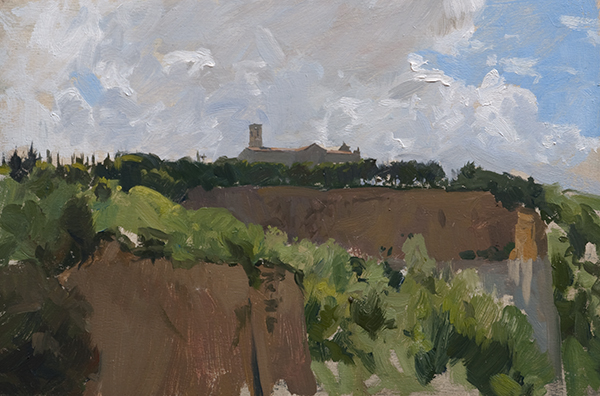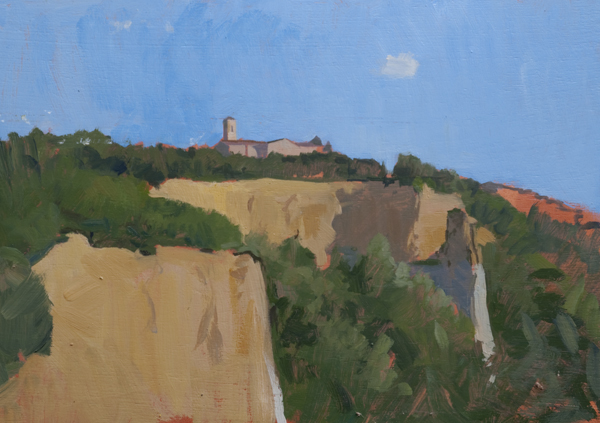Here are a couple of sketches from my plein air workshop near Volterra. The first I’m happy with, the second is awful.

San Giusto, Volterra. 20 x 30 cm, oil on panel.

San Giusto, Volterra. 25 x 35 cm, oil on panel.
The sketch above isn’t my fault. Really. Every month I make dozens of sketches and I usually buy large quantities of the gessoed boards from Zecchi. A few months back I got a batch from them where their subcontractor had messed up the proportions of the gesso and there wasn’t enough glue. The boards are too absorbent and are utterly unusable. Somehow they got mixed up into the next batch of boards I ordered and every now and then I find I’m trying to paint on one. It is impossible for me to pull anything decent off with one of these boards. I’ve had to throw away the ten or so paintings from the times I’ve insisted on trying.
On our workshops we give the students a full painting kit. It makes it easier for those who have to travel, but the reason we do it is really that we got tired of students arriving with unusable materials. Rubens couldn’t paint with some of the set-ups these people arrived with. Often they don’t have the experience to recognize that it’s their materials that are the problem. Since we started giving out full kits, we’ve seen a marked improvement in the students paintings. They are able to focus on learning to paint.
Good quality painting materials don’t have to be expensive either. Here in Florence we find the Zecchi brand is fine for paints (for dark ultramarine we use Old Holland). In the US, Blue Ridge and M. Graham both make excellent paint for reasonable prices. Often ‘student-grade’ paints are so full of fillers that to change one color you have to add a ton of the other one. This means the cost savings is gone when you calculate how much paint you actually have to use.
Good boards are cheap. Ray Mar is a good supplier in the US, Zecchi in Europe (when they get them right), or make your own. I use a cigar-box clipped to a $50 easel for most of my sketches. Brushes are really important but they don’t have to be expensive and will last for years if looked after properly. There is no excuse to skimp on materials if you care about painting.
At the end of the day, painting is hard enough without fighting your materials.
Beautiful painting, Marc!
Wish I could paint an awful sketch like that!
Wonderful work Marc. Another good source for decent paint is RGH http://www.rghartistoilpaints.com/new/paints.shtml
There web site has a lot to be desired. Don’t be put off by it the paint is very good and the owner is great. I ordered a 37mm tube of Chromium Oxide Green and they ran out of it in that size. They sent me a 150mm tube for the same price.Very nice of them I thought.
Stapelton Kearns swears by there cadmium’s. I have a set of Cad Yellows from Blue Ridge which I think is very good for the price.
The Take It easel which is a remake of the Gloucester easel would be the way to go if one does a lot of out door painting and wants an easel that is almost imposable to blow over. Stapelton Kearns has his own signature model. They are hand made in Vermont so I’m not sure how one would get one in Italy. At the moment I’m saving up to get one, they are not cheap. I do think they are worth it as they are solid and you can get the height you want.
Marc, I was wondering if there was a way you could describe your favorite surface, ideal surface?
I know what oil primed linen is like, the paint slips along the surface and you can get great milage with just one brush load, the pros seam to like it but for me it’s too expensive. Other acrylic primed surfaces need a lot of oil. I have heard Utrecht makes a canvas acrylic Gesso that has similar traits as the oil prime? I have painted on RayMar acrylic primed canvas for years and was wondering if you think their’s is the right absorbency or not? Lately I have been experimenting with hardboard (like watercolor board) with clear gesso.
That’s so interesting – fascinating. It would be lovely if you could say what the painting kit you give out contains! (maybe you already have?)
What is so incredible in you paintings, what I think every time I’m looking at them (apart from the fact that they touch me – which is THE thing, and which so many, to be honest don’t) – is the way you know the eye easily detects subtle shifts – and so use them to enormous advantage – it’s so dammed fine!
there is a simple test for absorbency on boards, clear the mouth and swallow and then put the tip of your tongue to the board for a half second and pull away, it should have barely tugged, if it felt like it was sticking to the board then the ground is more than 15% absorbent, the 15-20% is about all you want, after testing if the boards are found to be too “dry” you can lightly spray with a thin retouch varnish which will correct the problem or very lightly oil out the board, either way problem solved before the first paint hits the board, however the actual problem is water based gesso, if one is painting with oils on a hard substrate then one should use a good oil ground to avoid such problems, and i agree Blue Ridge oil colours are very high quality,
Hi Marc! I am looking to purchase a portable easel and having trouble finding the right one. Can you recommend one?
Thanks ….. this is a really interesting blog. Just a thought about brushes. I find my bristle brushes wear out on the gesso boards I prepare for plein air, though I do sand away much of the ‘tooth’. I do tend to work in a rush and scrub away so maybe that’s why.
Thanks for sharing your experience
Andrew
I like them both.
The first is the most Chain Soutine-ish painting I’ve seen on your site. The foliage is great to look at.
I like the shadowed earth colour, the sharp drawing in the building, the clouds, all of it.
In the second I like the rosy smudge on the right side with the drawing in it, the painting in the cliffs, again the building is perfect, great cloud in the sky.
I like them both.
Hey Marc, what kind of priming do you prefer on a panel? Traditional gesso, acrylic primed, or oil primed?
I use traditional gessoed panels from Zecchi, in Florence. If I’m in the US I get the oil-primed-linen-mounted-on-panels from New Traditions.